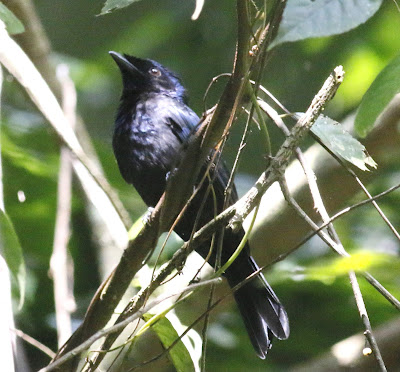 |
| Ashy Bulbul |
The color of its feathers certainly looks ashy alright but not sure why experts have re-named it as 'Cinereus bulbul" instead.
 |
| Grey-Headed Canary Flycatcher |
At times you can hardly see this flycatcher in your birding trips but other times they can just appear almost every where.
 |
| Pin-Stripped Tit Babbler |
There have been some local research conducted in Puchong some years back on the effect of brood parasitism on the population of its host and it was found that the population of some of its host have indeed been reduced. However this babbler seem to have no effect.
 |
| Mountain Fulvetta |
I think Mountain Fulvetta is more common than Brown Fulvetta over here.
This could be a sub-adult bird and this was also the first time i have managed to take its photos.
 |
| Slaty-Backed Forktail |
 |
| Black-Throated Sunbird - female |
Did not see the male this time.
 |
| Dark-Necked Tairlorbird |
You may asked me how did i know that it wasn't a common tailor bird instead ? Well just look at the color of their butt !
Here you go !
Here is an interesting looking bird. The color of its feathers was certainly brighter than a pale blue flycatcher.
It is not a disease bird but it was nevertheless a Pale Blue Flycatcher - a sub adult that is! See the photos below of another Pale Blue Flycatcher which were also taken on the same day for comparison.
This one has spots all over its body.
While this one above was probably in molt. Based on the above photos, would it be possible to say that the colors of Pale Blue Flycatcher changes from bright blue to pale blue as they mature?
 |
| Fiery Minivet - female |
Too bad the male Fiery Minivet did not stay long enough to be photographed.
Here is another family captured on camera.
 |
| Little Pied Flycatcher - male |
From the brown color of its rump, this could probably be a female Little Pied Flycatcher.
And this one here is probably their young one !
A look from another angle - from its back !
 |
| Verditer Flycatcher |
This flycatcher is slightly smaller than Pale Blue Flycatcher and the adult Verditer Flycatcher wears a Zorro like mask !
For comparison purposes, the middle one is a Pale Blue which was flanked by two Verditer Flycatchers !
"Awat hidung hang kemek macam itu?". This siamang also made its presence felt at this location albeit on a silence mode.
 |
| Blue Winged Leafbird - male |
 |
| Blue Winged Leafbird - female |
Glad to know that the Blue Winged Leafbirds are doing okay as well.
The above is certainly an Everett but how about the ones below?
 |
| Everett's White Eye |
I believe they were Everett's White Eye too instead of Oriental.
This Himalayan Stripped Squirrel had also came down to enjoy the feast.
Lastly before i packed my bag and gears to head for home, i saw a group of photographers from China who have just arrived. These are real china men from China whom was lead by a local birder. They were carrying a small portable recorder and they immediately set it aloud to the sound which sounded like 'kok' 'kok' then followed by the familiar calls of a hornbill. Amazingly out from no where came the majestic Great Hornbill !
You can call them insane or disgusting but they have somehow managed to lure the giant out from the forest and it did perched right in front of us.
Note: if you look closely at its median coverts, you will notice a small orangey/yellowish patch which color was actually secreted by some glands in male GHB.
Note: if you look closely at its median coverts, you will notice a small orangey/yellowish patch which color was actually secreted by some glands in male GHB.
 |
| Great Hornbill - male |
Luckily they were just a few bird photographer enthusiast and hopefully they did not spook this hornbill. If you travel up Genting Highlands lately you will noticed that there were lots of construction works up there which some are as big as a theme park at Johor Bharu. While no one will be critical about development works but the key word here is "sustainable development" ! Although from the photos depicted here and the earlier part 1 posting, you can see that the birds were breeding well at this location but with the massive development works going on now and in the future perhaps, one can only just wonder how long can the nature profile at this place be sustained !
Happy Birding !
NOTE: ULU KALI MOUNTAIN IS NOW CLOSE TO PUBLIC ! YOU CAN'T ACCESS THERE ANYMORE ! NO THANKS TO SOME OVER ZEALOUS PHOTOGRAPHERS !
































































